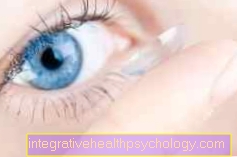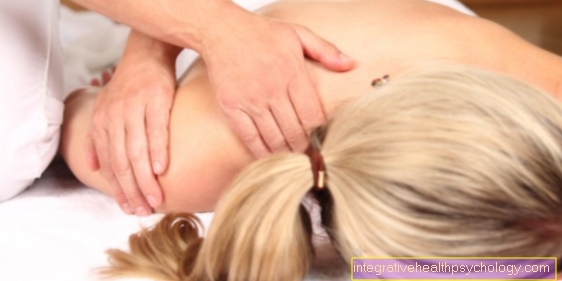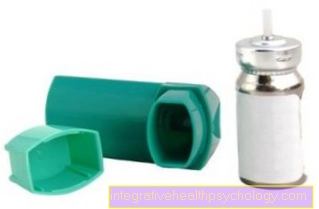Eye drops for dry eyes
introduction
Dry eyes can have a number of causes. They can be triggered by an allergy or caused by contact lenses. However, reduced tear production by the eye can also be responsible for a feeling of dryness.
Normally, the lacrimal glands constantly produce tear fluid, which covers the eye like a thin film. If this is not the case, the eyes feel dry and there is often a foreign body sensation in the eye.

Eye drops help
In the case of dry eyes, underlying diseases should first be ruled out by an ophthalmologist. It is therefore advisable to consult a doctor if the eyes remain dry for several days. If there is a decreased tear production, then eye drops can help to relieve dry eyes.
If permanent eye drops do not help, then an operative alternative should be considered, in which, for example, the drainage channel of the tears is closed so that the tear fluid is stuck in the eye.
Eye drops are not only used for dry eyes. Read more about this at: The different fields of application of eye drops
What is the difference between eye drops with and without preservatives?
Eye drops are mostly composed similar to our tear fluid. They are therefore also known as tear substitutes and are supposed to help against dry eyes.
You have probably already noticed that some eye drops are marked with “O K”, “SINE”, “SE”, “EDO” and more. These are eye drops without preservatives.
What are the differences between eye drops with and without preservatives?
The use of preservatives makes eye drops last longer. The preservatives protect against an accumulation of bacteria and other pathogens in the eye drop liquid.
This sounds positive at first, but with prolonged use it also has side effects. The preservatives can cause allergic reactions, irritation and corneal damage. The preservative benzalkonium chloride in particular is known for this.
Therefore, you should give preference to eye drops without preservatives, especially for daily or long-term use. These are more similar to our own tear fluid and better tolerated in the long term.
Eye drops with hyaluronic acid
Hyaluronic acid is found in many eye drops. This is an endogenous substance that binds more water. As a result, the tear film adheres better to the eye and the eye is kept moist. The stable tear film also protects the eye and lingers for a long time, so that less need to be dripped. It is therefore highly recommended to give preference to eye drops with hyaluronic acid.
You might also be interested in: The different fields of application of eye drops
Artelac (hypromellose) eye drops
Artelac eye drops contain hypromellose as an active ingredient.
This is one of the artificially created ingredients that have been used in eye drops for a long time. Hypromellose improves the adhesion of the tear fluid to the cornea by increasing its viscosity. This ensures adequate wetting and moistening of the eye.
Artelac also contains the preservative cetrimide. However, this is usually not a big problem, as the use of Artelac has only proven itself in between and only with slight dry eyes. Artelac eye drops are also popular with hard contact lenses as they can wet or moisten the contact lens.
Homeopathic eye drops
Although there are some homeopathic remedies for the treatment of dry eyes, the only long-standing remedy is only Euphrasia. This is a plant that has anti-inflammatory and antibacterial properties and is used in inflammatory processes in the eye. Other areas of application are dry eyes.
Another plant that is becoming increasingly important in the treatment of dry eyes is the medicinal plant Malva (Malva sylvestris). This plant has water-binding properties and forms a protective film on the eye. So it can be used for dry eyes.
Herbal eye drops
There are also many herbal eye drops that are effective against dry eyes.
The best known of them contain the active ingredient Euphrasia, also called eyebright. These drops are put into the eye once or twice a day as needed. In addition, eye drops with blueberry or chamomile can also be used.
A plant-based eye bath with euphrasia, aloe vera and hyaluronic acid is even more effective than drops.
We also recommend our site to: Euphrasia eye drops
Wala eye drops - Euphrasia plant
Wala eye drops are also known colloquially as “eyebright”. This is actually a medicinal herbal remedy from the Euphrasia plant. This plant is mainly found in western, southern and central Europe.
Due to their anti-inflammatory and antibacterial effects, Wala drops are mainly used for reddened, irritated eyes and allergic inflammation of the conjunctiva. Wala drops can also help with dry eyes, as they also regulate the fluid balance in the eye. Wala drops can also be used for tired eyes. Because Euphrasia has a refreshing effect, it helps treat stressed eyes.
Wala pots can also be used by pregnant and breastfeeding women, children and when using contact lenses.
Read more on this topic at: Euphrasia eye drops
Dry eyes from contact lenses
The contact lenses are in constant contact with the tear fluid in the eye because they rest on it. With soft contact lenses in particular, there is a risk that they will absorb the liquid from the eye and thus dry out the eyes. This is especially the case when working on a screen for a long time and when there is little blinking. In such a case, the use of artificial tears can exacerbate the problem of dry eyes.
If eye drops containing active ingredients or even antibiotic eye drops are used, soft contact lenses should not be worn. These absorb the dissolved active ingredients from the eye drops and this can lead to a local overdose. Hard contact lenses do not have this problem. The adhesion of the contact lenses when using eye drops is also made more difficult because the tear film that lies on the eye is thinned.
Particular care should be taken with eye drops containing preservatives in connection with soft contact lenses. The preservatives can build up in the contact lens and damage the cornea. This problem is not as pronounced with hard contact lenses.
Read more on the topic: Contact lenses for dry eyes
Eye drops for contact lenses
Contact lenses are very popular with many people for a variety of reasons. But especially the daily use of contact lenses can lead to evaporation of the tear fluid. This triggers an uncomfortable feeling of dryness in the eye.
If you do not want to do without your contact lenses despite this, weeping eye drops can help you further. However, you should urgently seek advice from your ophthalmologist beforehand! How your eye reacts to the eye drops depends on your contact lens and the composition of the eye fluid.
It is advisable to pay attention to the following:
- Prefer eye drops without preservatives:
Soft contact lenses in particular attract the ingredients contained in the eye drops. Thus, if your eye drops contain preservatives, the preservatives will be absorbed into the contact lens. These can damage the cornea of the eye! You should therefore urgently use preservative-free eye drops. In addition, it should not contain any phosphate. - Pay attention to the correct use of the eye drops:
It is recommended to use the eye drops at least 15 minutes before inserting the contact lenses. This is especially true for soft contact lenses. - Get advice from your optician or ophthalmologist:
Depending on whether you have hard or soft contact lenses, different eye drops may be suitable for you. Eye drops that contain hyaluron are recommended, as these can fix the tear film despite the contact lens. Artelac drops with the active ingredient hypromellase help with hard contact lenses.
Further information on this topic is available at: Contact lenses for dry eyes
application
The best-known eye drops for dry eyes are so-called tear substitutes. These are drops that mainly consist of water, but are also mixed with other substances so that they resemble the natural tear fluid. There are various active ingredients that can be used depending on the severity of dry eyes. They contain either polyvinyl alcohols, polyvidones or cellulose derivatives if the dry eyes are not very pronounced. However, if they cause major complaints, tear substitutes with carbomers, hyaluronic acid or dexpanthenol are used. The effectiveness and tolerance of the various active ingredients is different for every person. It may be necessary to test several in order to find the right product. Overall, it can be said that liquid eye drops should be used if the symptoms are minor and viscous drops help if the symptoms are more pronounced, as they stay in the eye longer. For example, Euphrasia eye drops are generally easy to tolerate because they are purely herbal.
Many of the artificial tear substitutes available contain preservatives to make them last longer. In general, however, drops without preservatives should be used, as preservatives often lead to side effects or inflammation.
Duration of use
The use of artificial tear substitutes for dry eyes is temporary unlimited. If a serious illness has been excluded as the cause, the eye drops can be used several times a day over a long period of time. Here are eye drops without preservatives preferable because preservatives affect the composition of the Tear fluid can be unbalanced.
When should you go to the ophthalmologist?
If the feeling of dry eyes persists for several days and is not due to any cause, a doctor should be consulted. A visit to an ophthalmologist is also advisable if the affected eye starts to hurt, swell or discharge purulent secretions. In such cases, an infection of the eye may have developed that requires urgent medical treatment.
Prescription Requirement
Almost all eye drops against dry eyes are without prescription available at the pharmacy. This applies to both herbal eye drops and preparations such as tear substitutes with other active ingredients.
Eye drops that work against dry eyes are fundamental does not require a prescriptionbecause they mimic the natural tear fluid of the eye. Only if there is a inflammation or bacterial infection has spread and it requires antibiotic treatment, so must prescription eye drops containing antibiotics be used.
Which eye drops are available without a prescription?
There are a number of medicines and homeopathic remedies that can be obtained without a prescription in pharmacies or on the Internet that can help against dry eyes.
In the following, the corresponding active ingredients are named by their trade names, but a visit to the doctor should not be avoided:
- Hypromellose: e.g. Artelac eye drops, Isopto- Naturale, Sic Ophtal N
- Povidone: e.g. Lacophtal, Protagent, Vidisept
- White vaseline: e.g. Coliquifilm
- Carbomer: e.g. Liposic, Vidisic
What is the cost of the eye drops?
Eye drops for dry eyes, especially tear substitutes, are not covered by health insurance in most cases. The costs are usually 4 to 20 euros per pack, depending on the pack size. In some cases, however, if there are serious underlying illnesses, the drops are only available on prescription. This is the case with damage or complete absence of the lacrimal gland, with so-called facial paralysis, i.e. one or both sides of the face in which the eyelids can no longer be closed, with rheumatism and other diseases that affect the eye. These include Sjogren's syndrome, an autoimmune disease in which, among other things, the tear glands are attacked, Epidermolysis bullosa, a skin disease, ocular pemphigoid, which affects the mucous membranes, and lagophthalmos, which causes the eyelid to not close completely.
What are alternatives to eye drops?
As an alternative to eye drops, eye spray or eye gels can be used. If eye drops do not help in the long term, surgical measures can be considered.
Spray against dry eyes
Spray products such as The SimilasanTears Again, are a good alternative for those who are intolerant of eye drops, as they have the same effect as the drops.
However, the application differs: The spray product is sprayed onto the lid with the eyes closed, then moisturizes the eye beyond the edge of the lid.
So there is no direct contact with the eye. For this reason, the dosage form as a spray is preferred by many, especially contact lens wearers.
Overall, however, the eye spray only helps with mild dry eyes.
Eye gel for dry eyes
Eye spray products or eye drops often do not work well enough for very dry eyes. In this case, eye gels such as e.g. Hylo Gel, help. Due to the viscous properties of the gel, the eye is moisturized to the maximum and for a long time. The eye gel also forms a protective film for the eye.





























